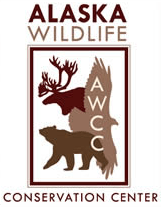Alaska Wildlife Conservation Center
|
AWCC logo | |
| Date opened | 1993 |
|---|---|
| Location | Municipality of Anchorage, Alaska |
| Land area | 170 acres (69 ha)[1] |
| Website |
www |
The Alaska Wildlife Conservation Center is a conservation center dedicated to preserving Alaska's wildlife. The center is located on 170 acres (69 ha) at the southern edge of Turnagain Arm and the entrance to Portage Valley in the Municipality of Anchorage.
The Alaska Wildlife Conservation Center is a refuge for orphaned or injured wildlife, as well as home or temporary home to captive born and translocated wildlife such as wood bison. The center has reintroduced elk back into Alaska , and is currently involved in a program for the reintroduction of the wood bison.
The Alaska Wildlife Conservation Center is open daily March through December, and on weekends in January and February.[2]
History
Founded by Mike Miller, The Alaska Wildlife Conservation Center opened in 1993 as the for-profit Big Game Alaska."[1]
In 1999, the center became a 501(c)3 non-profit organization, "Big Game Alaska, Inc. dba the Alaska Wildlife Conservation Center (AWCC)," with Miller serving as the center's executive director. The name was officially changed to Alaska Wildlife Conservation Center, Inc. in 2007.[1]
Animals
Animals at the center include Arctic fox, coyote, brown bear, black bear, moose, elk, musk ox, sitka black tailed deer, caribou, lynx and raptors.
Most of the animals are cared for in large natural habitats, including enclosures designed for the display of multiple (mixed) species. For instance, three brown bears live in an 18-acre (7.3 ha) habitat of rolling brushland and conifers, and two black bears are housed in a 14-acre (5.7 ha) enclosure with a stream.[3]
Education
The center offers educational programs and tours in self-guided, drive-through or walk-through formats.
Conservation
The AWWC has reintroduced elk back into Alaska.
Starting in 2003, the center has taken part in a program to reintroduce the wood bison back into Alaska after a 100-year absence. The wood bison is the largest land mammal in North America, and is a keystone grazing herbivore from the region. The first release date is scheduled for 2011.[4] This project is a joint effort with the Alaska Department of Fish & Game and other conservation groups.[5]
B.E.A.R.S. at AWCC
In 2008, the Alaska Wildlife Conservation Center embarked on plans to develop an Alaskan bear conservation science and education facility and interpretive center.[1][6]
The B.E.A.R.S. (Bear Education Awareness Research Sanctuary) exhibit, will be 11,000-square-foot (1,000 m2) "green" facility that will include habitat enhancements and an 30-acre (120,000 m2) expansion for the center's brown and black bear residents. In addition, an interpretive educational center and conservation research facility dedicated to advancing the public's awareness and appreciation for Alaska's bears (the polar bear, American black bear and grizzly or brown bear) is currently under development. The facility will permit visitors to explore interactive experiences featuring thematic displays of Alaska's bears while offering viewing of our own bears ambassadors on exhibit from inside the interpretive center or via webcam. Education and outreach programs will serve as the foundation for B.E.A.R.S. engagement programs. Conservation and science initiatives will serve to support the facility's outreach programs. The center has dedicated staff to develop B.E.A.R.S. as a resource hub for Alaskan Bear Conservation programs, inviting international colleagues and enthusiasts to visit and convey conservation message for Alaska's bears and the five other species around the world.
Media
Several documentaries, features films, and other video media have been shot on location at the Alaska Wildlife Conservation Center including a documentary for National Geographic and "Into Alaska" featuring Jeff Corwin in 2007, and "Into the Wild," starring Emile Hirsch.[7] Other special guests to the center include Jungle Jack Hanna who filmed a segment for his syndicated program.
In July 2010 the center's resident porcupine, "Snickers," gained worldwide publicity from video footage in which the friendly rodent appeared to behave like a puppy. The video went 'viral' on the internet in a matter of days.[8]
References
- ↑ 1.0 1.1 1.2 1.3 "Alaska Wildlife Conservation Center" "Alaska Wildlife Conservation Center, Inc. - Visitor Education and Research Sanctuary". legfin.state.ak.us. State of Alaska. April 2009. Retrieved 29 August 2010.
- ↑ "Visitor Information". alaskawildlife.org. AWCC. Archived from the original on 24 August 2010. Retrieved 29 August 2010.
- ↑ "Letter of support". legfin.state.ak.us. State of Alaska. 6 May 2009. Retrieved 29 August 2010.
- ↑ "Bison Reintroduction Program". alaskawildlife.org. AWCC. Archived from the original on 17 August 2010. Retrieved 29 August 2010.
- ↑ Schaul, Jordan (12 August 2010). "Wood bison to be returned to their ancient range in Alaska". nationalgeographic.com. National Geographic Society.
- ↑ "B.E.A.R.S. (Bear Education Awareness Research Sanctuary) of Alaska Center". alaskawildlife.org. AWCC. Archived from the original on 24 July 2010. Retrieved 29 August 2010.
- ↑ "Filming at Alaska Wildlife Conservation Center". alaskawildlife.org. AWCC. Archived from the original on 22 August 2010. Retrieved 29 August 2010.
- ↑ "Porcupine Acts Like a Puppy". huffingtonpost.com (Huffington Post). 20 July 2010. Archived from the original on 26 July 2010. Retrieved 29 August 2010.
External links
| ||||||||||||||
| ||||||||||||||||||||||||||
